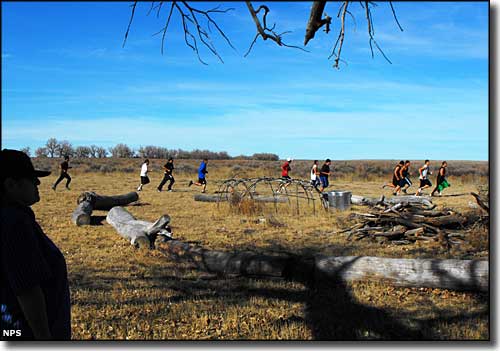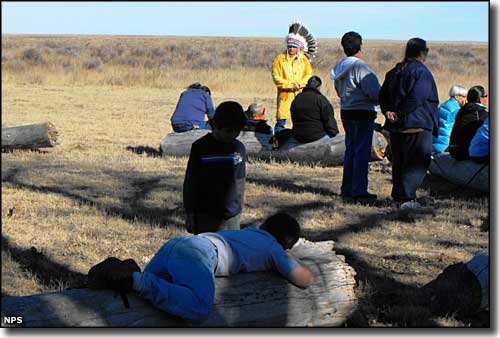
Sand Creek Massacre National Historic Site

Runners on the course of the Sand Creek Massacre Spiritual Healing Run in 2009
650 Colorado volunteers under Colonel John Chivington attacked a peaceful village of Cheyenne and Arapaho Indians on the morning of November 29, 1864. At the time of the attack, all the able-bodied men had been sent out to hunt for food so the village was filled with women, children and elderly men. Above the camp a United States flag waved in the breeze as a sign of their peaceful intentions. More than 150 of the encamped Indians died that morning, about 2/3 of them women and children. When the shooting was over, the troops proceeded to kill the wounded, mutilate many of the bodies and then loot the tipis and steal whatever horses remained. So many Cheyenne and Arapaho chiefs were killed that the traditional power structures of both tribes were severely affected and neither tribe ever fully recovered. And most of the chiefs killed were the ones most in favor of maintaining peaceful relations with the United States Government, US Army and the floods of incoming pioneers and settlers.
In the aftermath of the attack, Colonel Chivington, formerly a Civil War hero, was stripped of his rank and severely castigated by the government and the national press. The Federal government granted many of the Indian survivors 160-acre parcels of land in the area as recompense for what they went through and what they lost. The massacre caused many changes in the way the military and Federal government dealt with Native Americans afterward. However, the massacre also led directly to many of the surviving Cheyenne and Arapaho moving north and joining with the Sioux and Northern Cheyenne for another ten years of war against the Euroamerican invaders.
In 1998, the National Park Service was directed to locate the site and evaluate it for inclusion in the National Park System. Sand Creek Massacre National Historic Site was established in 2007. Since then, representatives of the Cheyenne and Arapaho have traveled from Montana, Wyoming and Oklahoma to visit and participate in an annual Sand Creek Massacre Spiritual Healing Run at the end of November. The photos on this page are from the Spiritual Healing Run of 2009.
The authorized boundary for the National Historic Site would encompass some 12,500 acres. As of 2006, the actual acreage owned was 2,385 after the Cheyenne and Arapaho Tribes of Oklahoma completed the transfer of 1,465 acres to the National Park Service to be held in trust for the Site.
Sand Creek Massacre National Historic Site is open from 9 am to 4 pm daily between April 1 and November 30. The site is closed from December 1 through March 31. Access requires driving over eight miles of sand/dirt road - which can be nasty in snow or rain. There are no fees involved. Camping at the site is not allowed.

Scene during the Sand Creek Massacre Spiritual Healing Run in 2009
